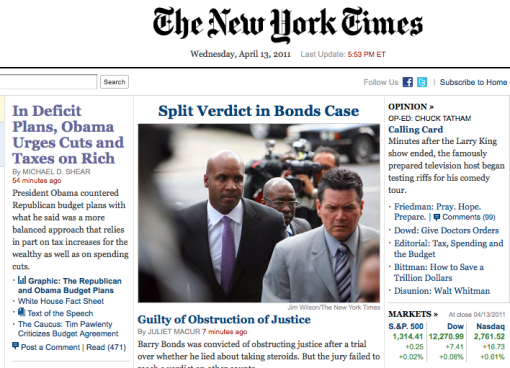So I read the news a lot, from a lot of different sources. One of the most interesting things I follow is how current events and hot issues are framed, meaning words and rhetoric that is used to describe them. This post will be short (I have to run to work in just a minute), but in the future I hope to go into more detail and explain some of the cognitive science behind it.
Today Obama released a new proposal on how to reduce the national debt— by some 4 trillion over the next 12 years. Bold. Here’s the reaction by NY Times:
“In Deficit Plans, Obama Urges Cuts and Taxes on Rich.” Small print, with more space actually devoted to a Barry Bonds sidestory (with accompanied picture). Title is also slightly confusing; parsing it out, you can read it one of two (or perhaps more) ways: Cuts AND Taxes on the Rich, as in there will be cuts in some places, and taxes in others? Are they new taxes or just old ones? Confusing, not clear, not attention grabbing (for an issue which will likely play out huge in the next few days, this is very surprising).
Now take a look at Fox News:
Look the visualization provided. The text size is huge, the colors vivid. Behind all that, the rhetoric and the framing its tactful and precise: It leads with a hook, a question that automatically frames Obama’s action as disingenuous: is this something Obama actually believes in? Is he just playing us? The two other words that are critical to this headline: “targets,” and “earners.” Targets sets up an attack frame: Obama is getting ready to attack someone. Who? The “earners.” Who are earners? Generally, they are people who worked for what they’ve gained, thus “earning” it. They got their wealth fair and square, or so this frame suggests. So without explicitly saying it, this title already tells you what to think about the story: What Obama is planning to do is bad. He wants to attack people who got their wealth fairly. “How is that just?!” it screams.
Two stories based off the same action. Which one do you think wins amongst the typical, uneducated American?

